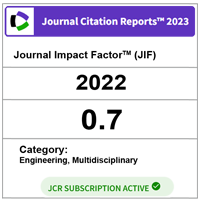SIMULATION OF LINEAR AND NON-LINEAR SOIL WATER DEFICIT DUE TO TREE WATER UPTAKE
DOI:
https://doi.org/10.11113/jt.v76.5433Keywords:
Water uptake simulation, linear, exponential, sensitivity analysis, total water extraction.Abstract
Simulation of water uptake model is extremely important to anticipate the moisture content changes in the soil. It is very helpful for the development of geotechnical foundation and geo-environmental problem solving. There are several water uptake models that have been developed by previous researchers. However it is difficult to plot and to analyse the model. Hence, this project focuses into the development of coding for linear and non-linear water uptake models. Linear model and exponential model were simulated by using Visual Basic. The results were verified and showed a good match with the models. The sensitivity of the linear and the exponential model was investigated, followed by the comparison between both simulated models. The results show that the total water extraction of the linear model is not affected by rooting depth, but very sensitive to potential transpiration. For the exponential model, the increment of the total water extraction is equal to the increment of potential transpiration. Besides, the extinction coefficient, b produces the least affect to the total water extraction. The total water extraction of the linear model is lower than that of the exponential model. For a common potential transpiration of 0.4 cm/day, the rate of the extraction is almost zero at 60% rooting depth and deeper when b value is 0.15/cm and higher.
References
Liew, S. S. and Liong, C. H. 2006. Two Case Studies on Soil Slope Failures. Malaysia.
Bosela, P. A., Brady, P. A., Delatte N. J., and Parfitt, M. K. 2013. Failure Case Studies in Civil Engineering. New York, CT: ASCE.
Brirish Standard Institution. 2005. B.S. 5837. London: British Standard Institution.
Nelson, J. and Miller, D. J. 1992. Expansive Soil. New York, CT: Wiley-Interscience.
Jones, L. D. and Jefferson, I. 2012. Chapter C5 – Expansive Soils. Instituition of Civil Engineers Manuals Series.
Dardanelli, J. L., Ritchie, J. T., Calmon, M., Andriani, J. M., and Collino, D. J. 2004. An Empirical Model for Root Water Uptake. Field Crops Research. 87: 59-71.
Kumar, R., Shankar, V., and Jat, M. K. 2013. Efficacy of Nonlinear Root Water Uptake Model for a Multilayer Crop Root Zone. Journal of Irrig. & Drain. Engineering. 139: 898-910.
Lv, G., Hu, W., Kang, Y., Liu, B., Li, and Song, J. 2013. Root Water Uptake Model Considering Soil Temperature. Journal of Hydro. Eng. 18: 394-400.
Mathur, S. and Rao, S. 1999. Modelling Water Uptake by Plant Roots. Journal of Irri. & Drain. Engineering. 125(3): 159 -165.
Prasad, R. 1988. A Linear Root Water Uptake Model. J. Hydrology. 99: 297-306.
Li, K. Y., Boisvert, J. B., and Jong, R. D. 1999. An Exponential Root-water-uptake Model. Can. J. Soil Sci. 79: 333-343.
Downloads
Published
Issue
Section
License
Copyright of articles that appear in Jurnal Teknologi belongs exclusively to Penerbit Universiti Teknologi Malaysia (Penerbit UTM Press). This copyright covers the rights to reproduce the article, including reprints, electronic reproductions, or any other reproductions of similar nature.





